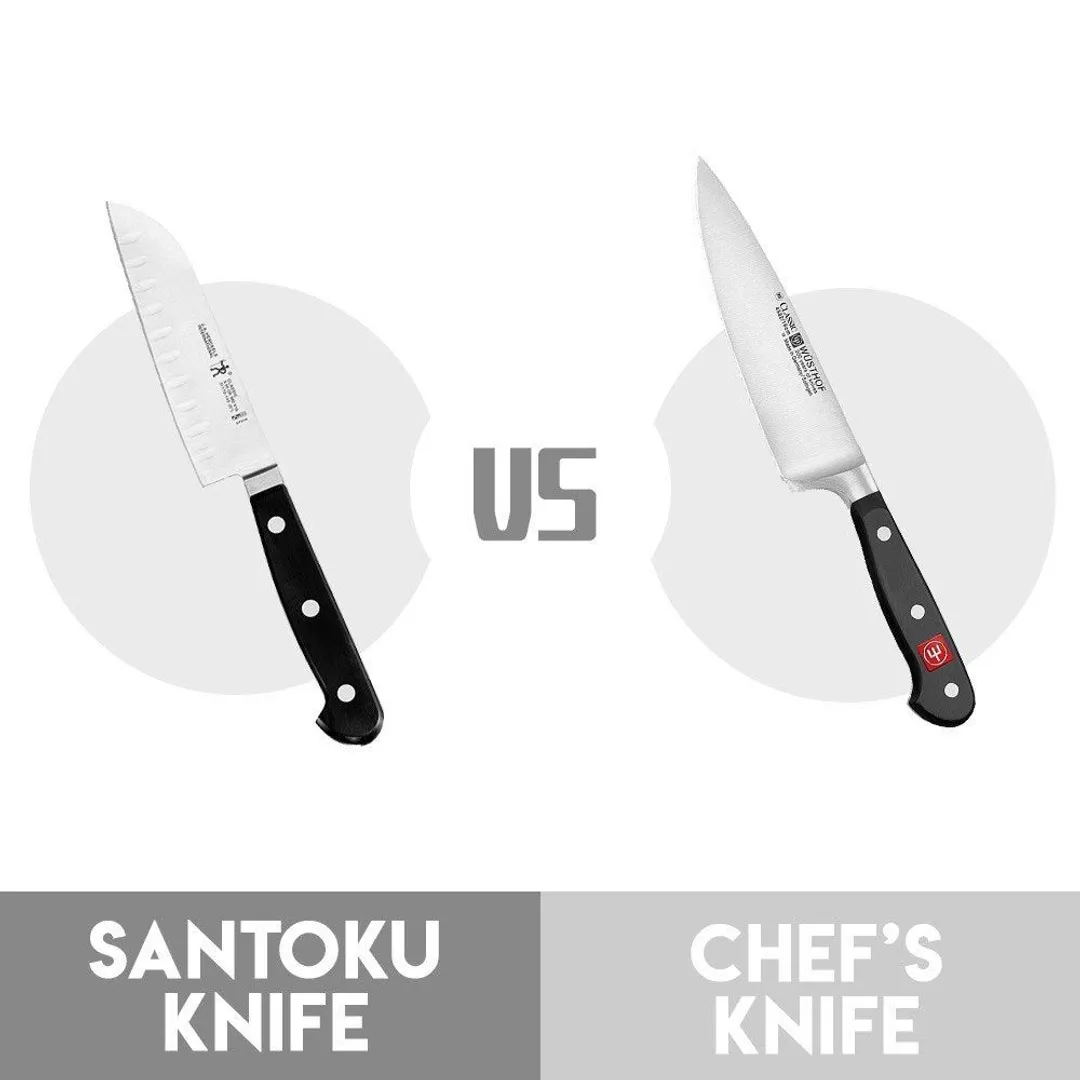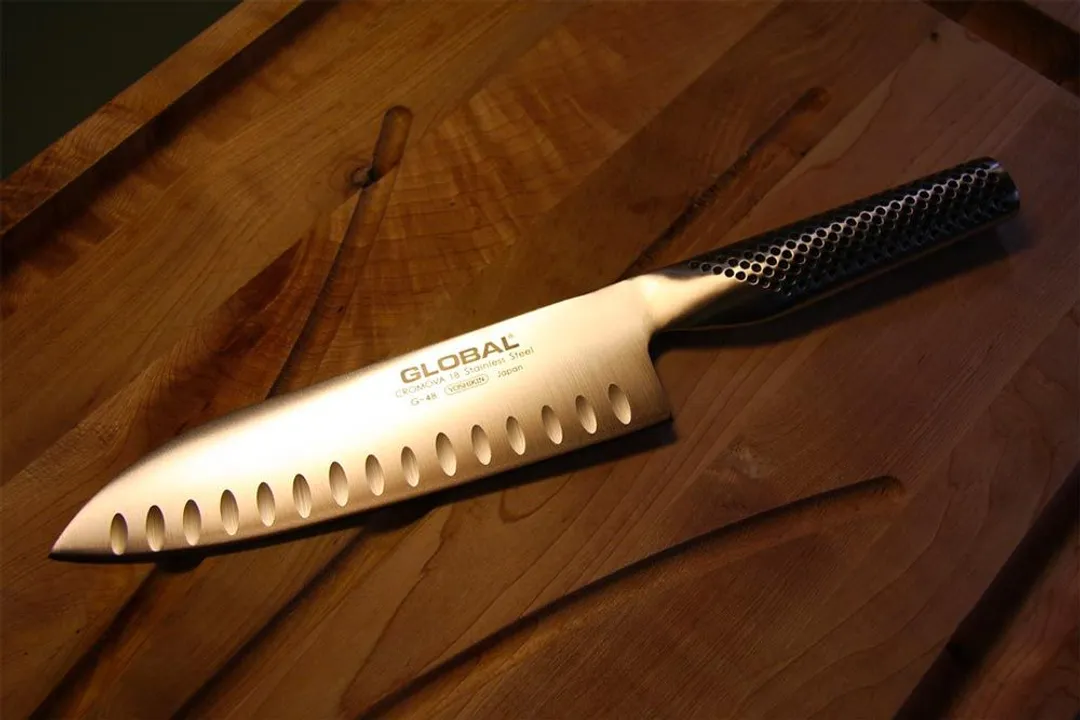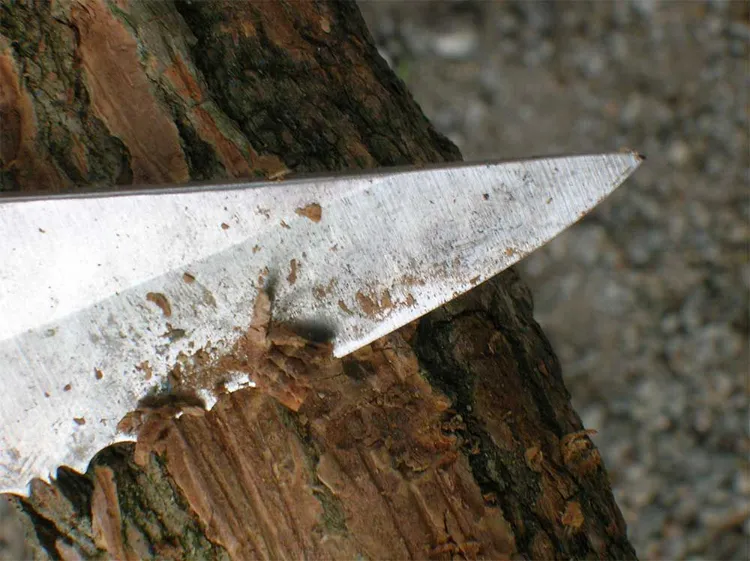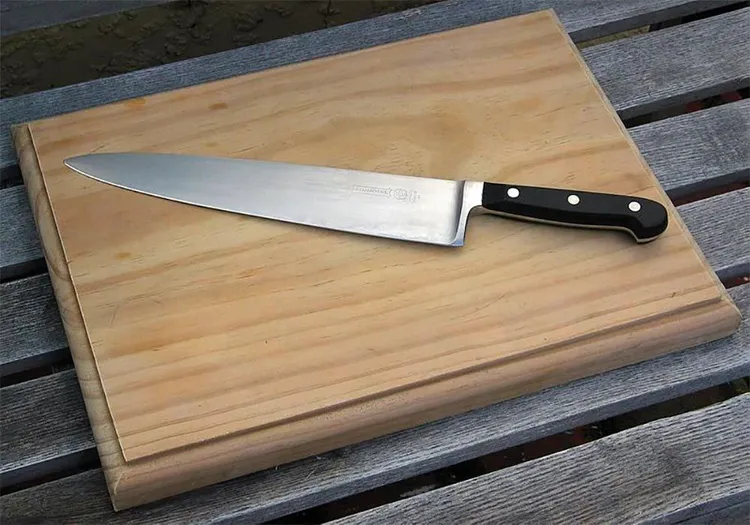Our recommendations are made independently through Research & Testing. We may receive commissions from purchases made via our links.
Santoku Knife vs Chef’s Knife: Ins and Outs of Two Kitchen Workhorses
The santoku knife vs chef’s knife bear many similarities, but there are important differences that give them unique roles in the kitchen.

The santoku knife is increasingly becoming a common sight in the kitchen, both at home and the restaurant. To the untrained eye, it is just another knife. But there are important differences between the santoku and the familiar chef’s knife that define their distinctive roles in the kitchen. Here, we’ll take a quick and dirty look at santoku vs chef’s knife and see what sets them apart.
Santoku Knife vs Chef’s Knife: A Quick Rundown
As general-purpose knives, the santoku and chef’s knife are both designed to be kitchen workhorses— to handle essential cutting tasks like chopping, slicing, dicing and mincing. They find wide acceptance among professionals and novices alike because they both have a niche to fill.
Before looking at their differences, let’s first see how they are similar. They are the most commonly-used knives in both the professional and home kitchens, and can often be seen side by side on the chopping board.
Their blades can be made of steel or ceramic. Professional chefs generally prefer steel because it is more versatile and resilient. Ceramic knives, however, find popular use in home kitchens thanks to their no fuss, no muss nature.
The steel of a typical santoku blade contains more carbon than that of a chef’s knife, giving it higher hardness as well as higher brittleness. In the world of steel, hardness and toughness are inversely proportional. A hard blade is more brittle and prone to chipping. A tough blade is more resilient but can’t obtain superior sharpness.
Because of this, the tough chef’s knife is easier to maintain and sharpen. Santoku can hold a sharp edge better, yet cannot withstand violent contacts with hard objects. It also requires more care to prevent rust, and therefore should be wiped dry after each wash.
Defining Features
The santoku and chef’s knife are shaped the way they are because of generations of use by cooks, and improvements by blacksmiths. One from the West and one from the East, their features cater to ingredients and cooking methods unique to their original parts of the world.
Santoku and chef’s knife features summary.
Feature | Santoku Knife | Chef’s Knife |
|---|---|---|
Blade shape | Sheep’s foot | Drop-point |
Blade thickness | Thin | Thicker |
Blade length | 5-8 in. | 7-10 in. |
Steel hardness | Harder | Softer |
Cutting edge | Straight | Curved |
Bolster | No | Yes |
Grantons | Common | Uncommon |
Edge grind angle | 10-12° | 15-20° |
Weight | Light | Moderate |
Since the function of a knife is first and foremost for cutting, the shape of its blade determines everything the knife is intended to do. The main difference between the santoku and chef’s knife stems from the shapes of their blades.
The blade of the chef’s knife assumes a drop-point shape, with the edge making a gradual curve from the heel to the tip. This makes the blade very well-suited for “rocking” cuts. Whereas, the santoku’s blade is thinner, takes on a sheep’s foot shape and is practically straight. Because of this, the santoku is a slicer or chopper rather than a rocker.
Grantons are a feature found on many santoku blades. These are oval depressions on the blade designed to create air pockets between the blade and the material being cut, thus preventing sticking.
Another important difference is the way the edge is sharpened. On a typical santoku, the bevel angle on each side is 10° to 12°, leading to a combined total of 20° – 24°. Compare this to the combined angle of 30° to 40° on a chef’s knife, the difference is substantial. This sharpness, accompanied by a thin blade and friction-reducing grantons, makes the santoku a superior slicer.
Bolster is the thicker metal junction between the blade and the tang, and can be found on most forged chef’s knives. It reinforces structural integrity, provides for a stable grip, and improves weight balance. It is not a common feature on the santoku due to different geometric requirements.
With a shorter and thinner blade, the santoku is lighter in weight than the chef’s knife. The chef’s knife feels more substantial in the hand with its weight and size. And rightly so, because it is meant to handle cutting things too tough for the santoku’s rather delicate blade.
How They Serve Your Cutting Needs
It used to be that the chef’s knife was the no-brainer choice in the kitchen as the main cutting utensil. But in the last couple of decades the santoku, a Japanese import, has made a strong presence in the West. Now these two heavyweights have become the mainstay of culinary cutting tools, each with a unique role to fill.
Santoku Knife

In Japanese, santoku knife’s full name is Santoku bōchō, meaning “three virtues” or “three uses”. It refers to the three types of cuts the knife is best at: slicing, dicing, and mincing. The weight distribution from the blade, tang to handle is optimized to make the santoku a very well-balanced knife when held in the hand.
But the santoku is not a forgiving knife to use. The blade is ultra-sharp and the grip style is all its own. When transitioning from a chef’s knife, careful practice is well-advised. Once versed in handling one, you’ll be able to slice vegetables, fish, or meat like never before.
For precision slicing cutting, santoku is the preferred choice. Just make sure it hits no hard bones. Due to the high brittleness the blade doesn’t stand up to hard surfaces.
Chef’s Knife

The chef’s knife didn’t become a staple in the kitchen drawer for no reason. It is a highly versatile knife that finds a place in almost any cutting situation. It can dismantle a whole roast chicken into main pieces with the robust heel, then take the pieces apart by precision cuts with its pointed tip.
So versatile is the chef’s knife that it doubles as a garlic-press with the wide blade, a bone-breaker with its hefty spine, and freezer bag-opener with the pointed tip.
And thanks to the higher toughness by way of a softer steel, the chef’s knife can take more abuse than the santoku, while being easier to sharpen and maintain.
Conclusion
It’s quite obvious from this santoku vs chef’s knife comparison that these two knives are not variations of each other. They are very capable tools in their own right. The santoku serves as a specialist in precision cutting, while the chef’s knife is a generalist that wears many hats. For a Western kitchen used to having only the chef’s knife around, a santoku might be a welcome addition, especially if your cooking involves lots of slicing.
Authors
Luna Regina is an accomplished writer and author who dedicates her career to empowering home cooks and making cooking effortless for everyone. She is the founder of HealthyKitchen101.com and HealthyRecipes101.com, where she works with her team to develop easy, nutritious recipes and help aspiring cooks choose the right kitchen appliances.






